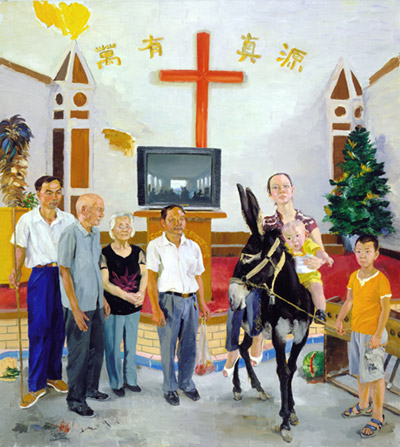LIU XIAODONG
| December 1, 2010 | Post In LEAP 6

Liu Xiaodong first came to the town of Yanguan in the northwestern province of Gansu in the fall of 2008 to paint the horses for which it is famous. Captivated by this diverse locale, he returned a year later to make portraits of its citizens, a project that soon became a cross-cultural comparison between a Muslim and a Christian family he found in the center of town.
In the Mary Boone Gallery in New York, it is safe to say that most visitors looked at the faces in the resulting paintings and just thought that they all looked Chinese. But, even a momentary glance at the costumes and surroundings revealed a study in contrasts. In the large painting, H’s Family (all works 2009), the artist managed to squeeze in a husband and wife, three daughters and a son, and a couple of house cats in the comparatively cramped space of their family café. There are a number of indications that the family is Muslim: the father and son wear white skull caps, the mother and two of her daughters wear headscarves and behind them is a mosque-like door, a symbolic entryway indicating the direction of Mecca. Liu Xiaodong wanted to paint the family in the local mosque, but nonbelievers were forbidden to enter. Instead we get their café, with patterned oilcloths on the tables and bottles of fruit drinks on the shelves.
Liu Xiaodong’s true talent is his ability to pluck subject matter out of the news—evacuees at the Three Gorges Dam site, soldiers stationed between the Mainland and Taiwan. Thus, the situation of the Uyghurs in nearby Xinjiang could not have been far from his mind when he painted this Muslim family in Yanguan. More so, because he contrasts their home with that of a Christian family’s church, just down the road, in Z’s Family. Here, a big screen television dominates the altar of the humble chapel where the family stands, posing for the artist. There’s a huge orange cross and a little Christmas tree in the background, but the most dominant character in the frame is a very funny donkey, looking askance at the group. Grandpa and grandma are present, with their two sons dressed in bland slacks and white shirts. Mom sits off-kilter on the beast, holding a baby, like a Virgin Mary, while her other son holds the rope. Are these families—H’s and Z’s—that different from each other? And what makes them anything other than Chinese?
It is fascinating how Liu Xiaodong’s paintings often raise social issues without delivering a hard-line message. This is entirely due to the lush, immediate quality of his brushwork. He also has a knack of capturing his subjects’ expressions—most probably, slightly bored from posing for him—which makes them come alive as individuals. In The Second Daughter, H’s girl, wearing glasses and a bright green top, seems entirely believable as a typical teenager whereas her sister, The First Daughter, is a Maja, dressed demurely but laying seductively in a niche in the wall. In The Daughter-in-Law, Z’s wife poses in a lively striped blouse in front of the glitzy Christmas tree, staring out with a guarded expression while, in another portrait, The Son, her husband looks slightly confused by the artist’s attention, as he stands in front of the TV on a podium that reads, “God is Everyone.”
God is Everyone in Liu Xiaodong’s world, where major conflicts and minor annoyances are revealed in every face. This series was warmly received in New York, especially by those who saw similarities between his painting style and Eric Fischl’s best work of the 1980s. It is not coincidental that they made the comparison; Fischl in fact introduced the artist to Boone after a trip to China in 2007. What makes Liu Xiaodong’s paintings entirely his own is his choice of subject matter, the way he compresses larger issues into the limits of history painting. In his brief essay in the accompanying catalogue, Liu wonders about the impact of religion and indicates that he fully appreciates that these religious struggles have been going on since ancient times. Rather than offering a didactic conclusion, Liu lets us see the humanity behind the headlines. For this reason, his work feels timeless. Barbara Pollack

